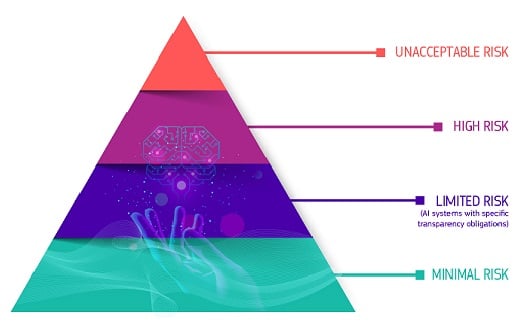Services List
AI Strategy
In a monumental move, the European Union has established the first-ever legal framework on Artificial Intelligence (AI), aptly named the AI Act. This groundbreaking legislation aims not only to mitigate the risks associated with AI technologies but also to position Europe as a frontrunner in the global AI arena.
-Apr-02-2024-06-26-09-8629-AM.png?width=2500&height=1500&name=Feature%20images%20velocity_%202500%20x%201500%20(1)-Apr-02-2024-06-26-09-8629-AM.png)
Covered in this article
The Essence of the AI Act
The Imperative for AI Regulation
A Risk-Based Framework
Enforcing and Implementing the AI Act
Looking Ahead
The Essence of the AI Act
The AI Act is meticulously designed to provide both AI developers and deployers with transparent requirements and obligations, especially in the context of specific AI applications. Furthermore, the Act is tailored to alleviate the administrative and financial burdens that often weigh down businesses, with a particular focus on supporting small and medium-sized enterprises (SMEs).
This Act is a cornerstone of a broader strategy to cultivate trustworthy AI within the EU. This strategy encompasses the AI Innovation Package and the Coordinated Plan on AI. Collectively, these initiatives aim to ensure the safety and uphold the fundamental rights of individuals and businesses in the AI domain, while simultaneously encouraging AI adoption, investment, and innovation across Europe.
The Imperative for AI Regulation
With the rapid evolution of AI, it's become increasingly clear that while many AI systems present minimal risk, there are certain applications whose potential adverse impacts cannot be ignored. The AI Act addresses these concerns head-on, ensuring that AI technologies remain beneficial and trustworthy for all Europeans.
One of the critical challenges with AI is the often opaque nature of decision-making processes, which can lead to unjust outcomes, such as biased hiring practices or unfair public benefit decisions. Although existing laws offer some level of protection, they fall short of addressing the unique challenges posed by AI systems. This gap necessitates the AI Act's comprehensive approach to AI regulation.
Learn more about global AI regulations
A Risk-Based Framework
The AI Act introduces a nuanced, risk-based classification for AI systems, ranging from unacceptable risk to minimal or no risk. It outright bans AI applications that pose a clear threat to people's safety and rights, such as governmental social scoring or certain AI-enabled toys that could promote harmful behaviors.
High-Risk AI Systems
For AI technologies deemed high-risk, the Act stipulates stringent prerequisites before these can enter the market. These include:
- Comprehensive risk assessment and mitigation measures.
- The utilisation of high-quality data sets to minimise risks and prevents discriminatory outcomes.
- Detailed activity logs to ensure the traceability of AI decisions.
- Extensive documentation to facilitate compliance assessments by authorities.
- Clear communication to deployers about the AI system's capabilities and limitations.
- The implementation of human oversight mechanisms to further reduce risk.
- Ensuring robustness, security, and accuracy of AI systems.
Moreover, all remote biometric identification systems are categorised as high-risk and are subject to strict regulations, particularly their use in public spaces for law enforcement purposes is, as a rule, prohibited with very few exceptions under stringent regulations.
Addressing Limited Risks
For AI applications with limited risk, such as chatbots, the Act mandates specific transparency obligations to foster trust and ensure that users are aware they're interacting with a machine.
Minimal or No Risk AI
The AI Act encourages the unrestricted use of AI technologies that pose minimal or no risk, encompassing applications like AI-driven video games and spam filters, which represent the majority of AI systems in use within the EU today.
Learn more about the AI risk-based framework

Enforcing and Implementing the AI Act
The enforcement and implementation of the AI Act will be overseen by the newly established European AI Office, in collaboration with member states. This entity is dedicated to ensuring that AI technologies respect human dignity, rights, and trust, and it plays a pivotal role in fostering collaboration, innovation, and research in AI. Furthermore, it actively engages in international dialogues to align global AI governance standards.
Learn more about the enforcement of the AI Act
Looking Ahead
The political agreement reached in December 2023 between the European Parliament and the Council of the EU marks a significant milestone towards the formal adoption of the AI Act. The Act is set to come into effect 20 days after its publication in the Official Journal and will be fully applicable two years later, with specific provisions being phased in gradually.
In anticipation of this new regulatory landscape, the Commission has initiated the AI Pact, a voluntary scheme encouraging AI developers worldwide to align with the AI Act's key obligations ahead of its formal implementation.
Learn more about the AI Pact
At Velocity, we recognise the profound implications of the AI Act for businesses and the broader societal landscape. Our commitment to leveraging AI responsibly aligns with the principles and requirements outlined in the AI Act, ensuring our clients and partners benefit from AI technologies that are not only innovative but also ethical and compliant with the highest regulatory standards. Contact us today to find out more about how AI can assist your company in its marketing efforts.



